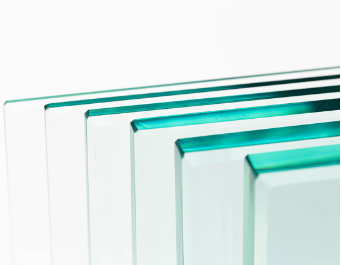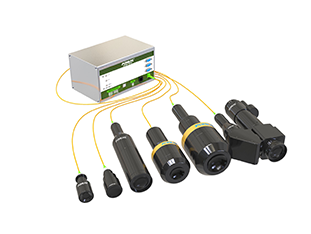Spectral Confocal Sensor Applied to Glass Substrate Aperture Measurement
Spectral Confocal Sensor, also known as Color Confocal Sensor, is a high-precision device that uses the principle of light interference and confocal effect to measure the tiny displacement and distance on the surface of an object. Its basic principle is to establish the correspondence between distance and wavelength through the optical dispersion principle, and use the spectrometer to decode the spectral information so as to obtain the position information.
After the light from the white LED light source passes through the fiber optic coupler, spectral dispersion occurs after focusing through the collimating and dispersive objective lens, forming continuous monochromatic light intersection points on the optical axis. The distance from each monochromatic intersection point to the object to be measured is not the same. When the object is in a position in the measurement range, only a certain wavelength of light focused on the surface of the object to meet the conditions of confocal, so that it can be reflected from the surface of the object back to the fiber optic coupler and into the spectrometer. The spectrometer decodes the wavelength value at which the light intensity is maximum, and then measures the distance value corresponding to the target.
Due to the confocal technology, the spectral confocal sensor has good laminar characteristics, improves resolving power, and is insensitive to DUT characteristics and stray light. In addition, spectral confocal sensors can maintain high measurement accuracy and stability in complex lighting environments, making them suitable for a wide range of applications.
Glass substrate aperture measurement difficulties:


① The brittleness of the glass substrate increases the risk of processing and measurement, and a little carelessness may cause breakage.
② The high transparency of glass makes it easy for light to penetrate, resulting in a weak reflected light signal and increasing the difficulty of measurement.
③ Tiny scratches or unevenness on the glass surface will also affect the accuracy of the measurement results.
In aperture measurement, there is a need to ensure the accuracy and stability of the measurement. However, due to the characteristics of glass substrates, traditional contact measurement methods may cause wear or contamination, affecting the accuracy of the measurement results. Therefore, non-contact measurement methods have become the preferred choice for glass substrate aperture measurement.
POMEAS Spectral Confocal Sensor PMS-SFS-D8040 demonstrates significant advantages in glass substrate aperture measurement with its high accuracy, high resolution and non-contact measurement.


1. High-accuracy measurements: The PMS-SFS-D8040 has a maximum linearity error of only ±1.4 μm, an extremely low error value that ensures its superior performance under micron-level accuracy requirements. It provides stable and highly accurate measurement data even with small variations in glass substrate aperture.
2. Non-Contact Measurement: The PMS-SFS-D8040 is able to measure without directly touching the object under test, effectively avoiding wear and tear or contamination due to contact. This is especially important for fragile and highly transparent materials such as glass substrates.
3. Wide Light Angle: The PMS-SFS-D8040 has a maximum light angle of ±20.2°, a parameter that reflects the angular range of the sensor when receiving light. The wide light angle allows the sensor to maintain high measurement accuracy and stability even in complex lighting environments, making it suitable for complex scenarios of glass substrate aperture measurement.
4. High Numerical Aperture: The PMS-SFS-D8040 has a numerical aperture of 0.31, which is an important indicator of the sensor's light collection capability. The high numerical aperture ensures that the sensor can still capture enough light for accurate measurements in low light or complex lighting conditions, which is suitable for low reflected light signals that may be encountered in glass substrate aperture measurements.
5. Software support: POMEAS spectral confocal sensors are also equipped with specialized software such as CCSVR1.0.2.4, which is user-friendly, easy to operate and powerful. It supports a variety of measurement modes and data analysis functions, providing users with a comprehensive measurement solution and further improving the efficiency and accuracy of glass substrate aperture measurement.
POMEAS Spectral Confocal Sensor PMS-SFS-D8040 shows significant advantages in glass substrate aperture measurement with its high accuracy, high resolution, non-contact measurement and wide light angle.
Product recommendation
TECHNICAL SOLUTION
MORE+You may also be interested in the following information
FREE CONSULTING SERVICE
Let’s help you to find the right solution for your project!


 ASK POMEAS
ASK POMEAS  PRICE INQUIRY
PRICE INQUIRY  REQUEST DEMO/TEST
REQUEST DEMO/TEST  FREE TRIAL UNIT
FREE TRIAL UNIT  ACCURATE SELECTION
ACCURATE SELECTION  ADDRESS
ADDRESS Tel:+ 86-0769-2266 0867
Tel:+ 86-0769-2266 0867 Fax:+ 86-0769-2266 0867
Fax:+ 86-0769-2266 0867 E-mail:marketing@pomeas.com
E-mail:marketing@pomeas.com
